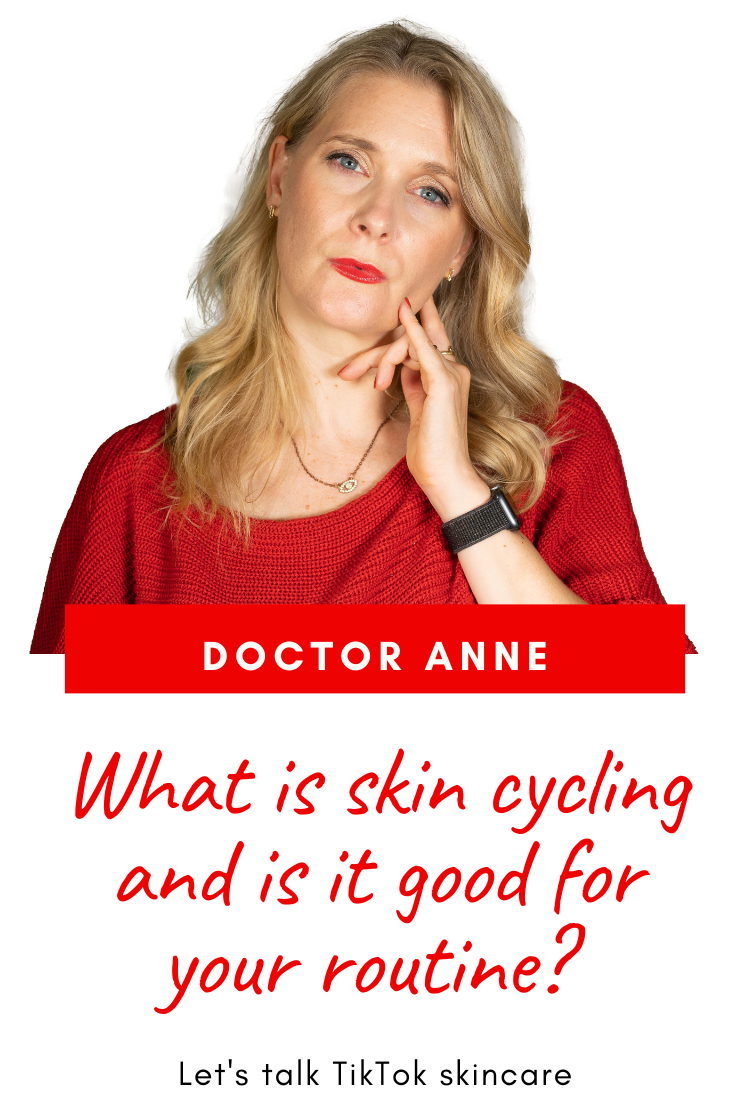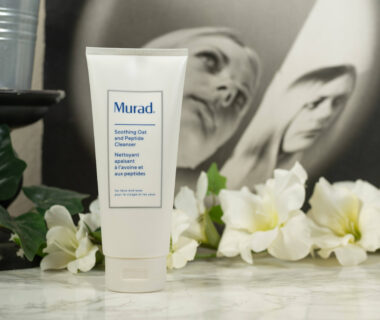ADVERTISEMENT INFO: PRODUCTS LINKED MIGHT BE PR, LINKS USED ON THE BLOG ARE AFFILIATE LINKS. I RECEIVED NO MONEY TO WRITE THE BLOGPOST. PLEASE READ DISCLAIMER.
Every now and then a new skincare trend takes over TikTok and leaves everyone wondering: What the heck is it and do I need to do it? The latest – as far as I know, these trends seem to pop up quicker than I can keep up – being skin cycling.

But what actually is skin cycling? Is it essential for a good skincare routine and, most important, is it really new or like the big shoulder pads, just recycled from a time before the current Tiktok demographic was even born?
What does skin cycling mean?
The concept skin cycling is based upon is that you shouldn’t use your strong actives like Tretinoin or strong chemical peels daily, but instead cycle the products you are using, meaning you use your active one night and soothing skincare (which can be simply your trusted and plain moisturizer) the next one. There are several “recipes” I have seen, offering different cycle lengths between the active nights or focusing on different actual actives or their combination, but the basic principle remains the same:
Give your skin a break and don’t overexfoliate or wreck your skin barrier.
(More info: Signs of a damaged skin barrier)
Where does skin cycling come from?
According to what you read on the internet, skin cycling is a method developed by dermatologist Dr Whitney Bowe who was looking for a way to help her patients with sensitive skin incorporate strong actives like Tretinoin and chemical exfoliants in their routine without irritation. Dr Bowe is a New York based dermatologist that has been active on social media for quite some time now – she started uploading on YouTube 8 years ago, but hasn’t been very active there in the last few months as far as I can tell – and has also written a book called “The beauty of dirty skin” that emphasizes the gut-skin axis and the role of the microbiome. I haven’t read the book or watched more than maybe a handful of her videos, so I can’t offer an opinion on whether I recommend following her advice, I just wanted to give you some background information.
Why can using actives every night be a problem?
We have talked about the skin barrier and its importance quite frequently on this channel, but as a quick recap: The upper layer of your skin is made up of dead skin cells that can, if they don’t shed properly, lead to a dull and uneven appearance, something that can be helped with using an exfoliant, giving your skin back the much coveted glow.
As it is with all good things though, more doesn’t always give you better results. The dead skin cells do have a function as they make up the skin barrier, essential in keeping hydration in and potential irritants out, meaning that if you exfoliate too much of them away, you lose that protection and can aggravate dehydration and skin irritation.
Same is true for strong retinoids, usually the prescription form like Tretinoin and Adapalene, that are used as part of acne treatment, but also gained popularity in those not suffering from acne for anti aging. They are amazing products, but they do come with a relevant risk for irritation that often presents itself with tight, red, flaking and uncomfortable skin.These effects usually don’t happen directly when you start using the products, but after the first two or three weeks, which can make it even harder to avoid – you think you are fine, you keep using them daily and then, seemingly overnight, your skin flares up and you are in for a few really bad weeks skinwise or simply stop the products altogether. (More info: Your comprehensive guide to retinoids)
How will skin cycling help the skin?
Skin cycling can help prevent these problems by reducing the frequency of actives used and giving your skin time to adapt – quite often skin can build a tolerance to strong retinoids over time, allowing you to increase the frequency and potency you can use without adverse effects.
And if these problems don’t appear, you are way more likely to stick to using these ingredients, which is the only way to see results – consistency is key in any skincare routine.
Can skin cycling help with acne?
Yes, skin cycling might help with acne – the emphasis being on the “help”. Acne – not to be confused with breakouts – is a skin condition that should be treated under a doctor’s guidance and often requires prescription to prevent long-term problems like scarring. Skin cycling on its own is not going to help that, but it might help you tolerate the treatment better, so you keep up with it and see results in the end.
Skin cycling on its own though can help breakouts that aren’t acne, as the overuse of some ingredients, often exfoliating acids, can lead in some people to their skin being more prone to pimples as a sign that it is irritated.
(More info: What is skinimalism and is it good for you?)
How do you do skin cycling?
The basic recipe you’ll find is: One night for your retinoid, next night you exfoliate, and the third night you let your skin recover before starting all over again – one extra recovery night recommended when your skin is particularly sensitive. I am not a fan of fixed recipes for every one, as each skin is different, and wanted to point out that depending on the strength of retinoid you are using, you might not need to exfoliate altogether, but I appreciate that having a fixed routine is what some people need to make things less complicated.
(More info: How to combine skincare ingredients the right way)
Is there an issue with skin cycling?
Now, there is no issue with skin cycling as a concept.
The only thing that irritates me is that it isn’t new. I made a post on “How to introduce Retin-A with minimal irritation” back in November 2019 that features all the things said here already, and I by no means introduced a new concept there, but merely shared knowledge that had been around for ages! Yes, it might not be part of what you are told at every doctor’s office – when I got my first prescription I was told to use it daily and “push through” the pain of the first two months – but before brands started to push high percentage exfoliants with the advice to use them twice daily, it was kind of common sense.
But even if, just like the shoulder pads I mentioned earlier, it is more of something coming back than a new revelation, I am not mad about it. Unlike said shoulder pads I really hope more people embrace this sensible approach to their routine while I sit back here, being the skincare grandma I am, smiling and saying: Haven’t I told you so all along?

Here are my current morning and evening skincare routines for inspiration on what to cycle
Don’t forget to check out the Discount Code Page on top if you want to save some money on your next skincare purchase.
If you want to get a vote in the next Ask Doctor Anne Topic, Ingredient Spotlight or product I review, don’t forget you can head over to my Patreon account to get more involved!


